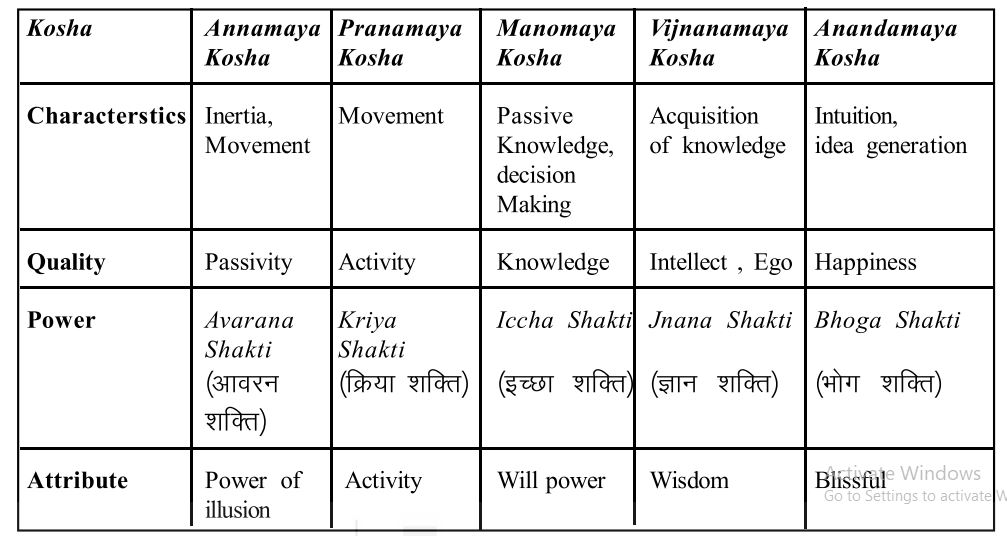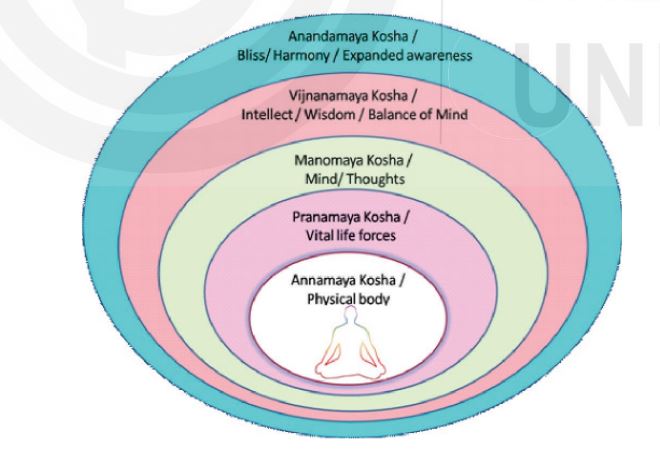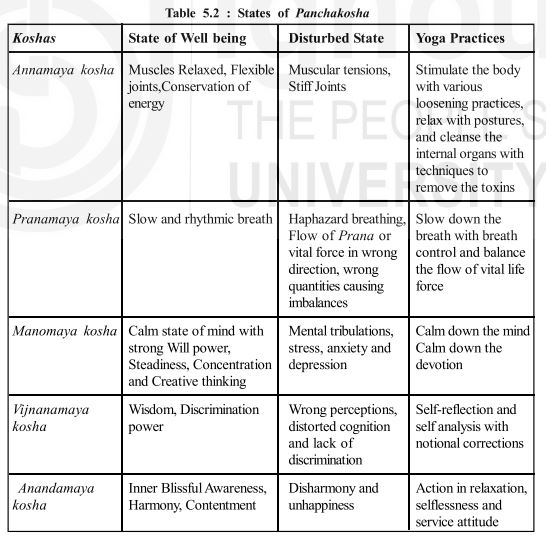Pancha Kosha
Pancha Kosha
Introduction
Yoga teaches us about the mechanism of body, mind, and spirit called Pancha Kosha Viveka (पंच कोष विवेक), which means knowledge of the five layers of our existence.
Vedanta (वेदान्त) explores the human individuality into five layers/sheaths (koshas) (कोश) or levels. It reveals the basic elements that give the macrocosm and the microcosm framework. It teaches us about the mechanism of the body, mind, and spirit, from the gross elements that make up the physical body to the more subtle aspects of the mind and consciousness. It identifies each element, teaches us its function, and shows us the relationship of all the elements with each other. Essentially, it can be called the model of the human being or the conceptualization of the human being, which is called Pancha-kosha-vishleshana (पंच-कोश-विश्लेषण), i.e., analysis of the five sheaths and is based on the Taittiriya Upanishad.
अन्नं प्राणो मनो बुद्धिर्– आनन्दश्चेति पञ्च ते । कोशास्तैरावृत्तः स्वात्मा, विस्मृत्या संसृतिं व्रजेत्
॥१.३३॥
Annam praanah manah buddhih ānandah iti pañca te, košā taih aavritah svātmā vismritiyā samsritim vajet (1.33)
Panchadasi
The human individual is comprised of certain layers or sheaths. The outermost sheath is the annamaya kosha (अन्नमय कोष), or the physical body, which is sustained and nourished by our food. The next layer, internal to the physical body, is the pranamaya kosha (प्राणमय कोष), or the vital body, which is maintained by the water that we drink. The vital body, or the mental body called manomaya kosha (मनोमय कोष), is located inner to the pranamaya kosha and is sustained by the subtle elements of the diet we take. Internal to the mind is the buddhi (बुद्धि) or understanding, the highly purified form of thought. Internal to the intellect is the last kosha, or sheath, called the causal body—through which we experience a kind of bliss when we are fast asleep.
The Pancha Kosha theory
Annamaya Kosha
- In Taittiriya Upanishad conversation between a father and son has been cited, who also happened to be Guru (गुरु) and shishya (शिष्य). The son, Bhrugu, asks the father, Varuna, to tell him about the most fundamental element of this universe from which all creation has come. The father leads him through hints to perform Tapas (तपस) (internal research) to find an experiential answer to the question. The son goes into silence and comes back to the father with an answer that this entire universe is made of 'Anna' (अन्न) (matter). Everything in the universe is sustained by Anna, and everything dissolves into Anna. Father is pleased that his son has arrived at one common principle of the external universe. This matter (Anna) based aspect of our physical personality is called Annamaya Kosha.
- Annamaya Kosha consists of five elements (Pancha Bhutas), namely earth (Prithvi) (पृथ्वी), water (Jala or Apa) (जल), fire (Agni or Tejas) (तेजस), wind (Vayu) (वायु), and space (Akash) (आकाश). It is nourished by the gross food that we consume.
- This is what modern science also has understood. It has successfully explained the intricacies of this kosha. Man in search of reality or the unchanging elementary unit of this universe, as a scientist, started with the gross external world of solid matter, which is simple and easy to see, divide, and do experiments with. This search led him through steps of understanding this entire world of matter, starting from elements, molecules, atoms, protons, neutrons, and electrons; He further understood that it is all packets of energy. The atoms conglomerate together to form various chemicals; our body is, therefore, a permutation and combination of multiple chemicals (Packets of energy in various configurations). They join together to form molecules, cells, tissues, organs, etc. These follow well-defined laws of nature and are controlled by nervous (electrical) and chemical (hormones) mechanisms to bring about movement and action in every cell. Thus Annamaya kosha is the physical frame that is the grossest of the five Koshas.
Pranamaya kosha
- Prana (प्राण), the vital energy described here, is not the material electromagnetic energy spectrum known to modern science. The body may be there, but it is gross and useless without life or Prana. This Prana is the basic fabric of this universe, both inside and outside our body.
- Prashna Upanishad verse II. 13 says, "all that is present in the three worlds rests in the direct of Prana. As a mother protects her children, oh Prana, protect us and give us splendor and knowledge.'
- A uniform harmonious flow of Prana to each cell of the annamaya kosha keeps them alive and healthy.
- Prana can move into different body areas (Annamaya kosha) depending on demand. When we perform more brain work, we need more Prana in the head region. When you walk, you need more Prana in the lower limbs, etc. If the prana flow to any organ increases inadvertently and without control, it can lead to dysfunction of that organ at the Annamaya kosha.
- Prana flows through subtle channels called Nadis (नाड़ी).
- The five dimensions of the Prana, which surge through resulting in activities in different areas, are called Pancha Prana (पंच प्राण).
- The downward force called 'Apana' is responsible for defecation, urination, menstruation, ejaculation, parturition, etc.
- The Prana responsible for breathing movement is called 'Prana.'
- Udana is responsible for upward activities like vomiting;
- Samana is responsible for proper digestion and balancing Prana and Apana.
- Vyana is responsible for all activities in the periphery like nerve impulses, blood circulation, and cellular activity in all cells.
- A balance between these five pranas is health, and an imbalance results in disease.
Manomaya Kosha
- Manomaya kosha is the aspect of one's personality wherein the mind carries on its different functions such as perception (manah) (मन), memory (chittah) (चित्त), and ego (ahankara) (अहंकार).
- Manah - is the active part that receives sensation/impressions gathered by the five senses of cognitions/ jnanendriyas (ज्ञानेंद्रिय).
- Chittah- the things perceived through the five senses of cognition are stored in the chittah/memory as impressions. Hence chittah is the storehouse of karma and samskaras (impressions).
- Ahamkara- is a sense of 'I' ness or the faculty of identity. It claims these impressions as its own and stores them as personal knowledge or identification of ourselves with the outer world, which comes with identifying ourselves with the body – Dehatma Bhava (देहात्मा भाव)(we think we are the body).
- We have understood that the mind is a conglomeration of thoughts that responds to the input through sense organs. For example, we see a big red flower; our eyes send the image to the brain, and the mind (manah) perceives it as a beautiful rose. Within the next fraction of a second, our memory (chittah) deciphers that it is a very rare variety of rose that we wanted to see and enjoy. The thought circulates in the mind and chitta, which soon makes you feel 'O, it is so beautiful! I like it. I love it. I want it!', This component of the manomaya kosha in which this swift recycling of thoughts takes place and gathers momentum is called the 'Emotion' (Bhavana) (भावना). It is characterized by feelings such as "likes or dislikes, " " love or hate, " and all human joy & distress. When the emotions become powerful, they start governing our actions against what is right.
- Yogi Vasistha says that 'going against cosmic laws' leads to imbalances called Adhi (आधि) or stress.
- Long-standing Adhis get pushed into pranamaya and annamaya kosha, causing Vyadhis (व्याधि).
- Manomaya kosha is our mental and emotional library, the subtler layer of our existence. Hence the statement 'you are what you think you are'.
Vijnanamaya Kosha
- Vijnanamaya (विज्ञानमय) kosha is the fourth layer of our reality.
- We all have two minds. e.g., when the manomaya kosha said, ' It is a beautiful rose, I want to have it,' you started instructing your hands to pick up the flower. Your inner mind said, 'Sorry, I cannot pluck this flower; it does not belong to me; it is from the neighbour's garden,' and you stopped the action. This inner voice that continuously guides us to do or not to do something is the Vijnanamaya kosha.
- This component of the mind has developed in the human race greatly that differentiates man from animals. Bharthruhari says,
आहार-निद्रा-भय-मैथुनं च समानमेतत्पशुभिर्नराणाम् ।
धर्मो हि तेषामधिको विशेषो धर्मेण हीनाः पशुभिः समानाः ॥
Ahara nidra bhaya maithunan cha, Samaanyametat pashubhih naraanam
Bhuddhirhi tesam adhiko visheshah, Buddhirvihinah pashubhih samanah.
- Hunger, sleep, fear, and procreative instinct are common to man and animals. It is the Buddhi (discriminating faculty) that is special for man. A person who does not have Buddhi is equal to an animal. Bhartruhari brings out this point about how the higher faculty, the Vijnanamaya kosha, continuously guides the manomaya kosha to master the basic instincts. Hence, we know that even these basic instincts are all psychological in man.
- For example, we have lost the cyclical behavior as in animals who get into reflex estrus cycles (heat for sexual behavior). This freedom element inbuilt in all human beings guides them to discriminate between what is 'good and bad', 'right and wrong,' 'useful and not useful' to move towards long-term sukha (happiness).
- Thus Vijnanamaya kosha is the discriminating faculty.
Anandamaya Kosha
- Ananda is the basic stuff of this universe from which everything has been created. It is called Anandamaya kosha – the bliss layer of our existence.
- It is the most subtle aspect of our existence, devoid of any form of emotions; a state of total silence – a state of complete harmony and perfect health.
- While in Manomaya kosha, the creative power predominates; in Vijananamaya kosha, it is the power to discern and discriminate. Bliss is embodied in Anandamaya kosha, the highest stage of evolution in the manifested existence.
In his inward journey towards the Ultimate, Man crosses these koshas of existence one by one. Through analysis called 'Pancha Kosha Viveka' (knowing through experience one's five koshas of existence) and the associated practices called 'tapas' or internal research, Man gradually becomes relieved from the bondages and constrictions of each kosha. It is one of the methods of reaching the ultimate goal, which is to get freedom from the cycle of death and birth, as enumerated and described in the Upanishads.
Classification of Pancha Koshas
The human body has three bodies where all these five koshas reside. They are Gross body (Sthula sharira) (स्थुल शरीर), Subtle body or Astral Body (Linga sharira) (लिंग शरीर) and Causal body (Karana sharira) (कारण शरीर). The gross body or Sthula sharira is the physical body. Subtle or Astral body or Linga sharira is the vital energy field, mental and intellectual state. Causal body or Karana sharira is the ego.
- Gross body or Sthula sharira - Food sheath and the gross portion of vital air sheath constitute the gross body. The Pranamaya kosha or the vital- air sheath interconnects the Annamaya kosha (physical body) with the Manomaya, Vijnanamaya, and Anandamaya koshas. It is associated with the sukshma sharira (subtle body) (सुक्ष्म).
- Subtle body or Linga sharira - The portion of vital-air sheath combined with mental and intellectual sheaths forms the subtle body. The mental and emotional sheaths transmit energy to the physical body via the Pranamaya kosha, which alters the breath to effect change in the mental/emotional states. The subtle body is constituted of passions, desires, emotions, feelings and thoughts.
- The causal body or Karana Sharira - Bliss sheath consists of impressions or vasanas alone.
A person who holds on to Annamaya Kosha believes that he is only the physical body. He is attached and consumed solely by the physical form. He gives more importance to physical things. Such persons are good sportsmen and love physical fitness programs like games, sports, aerobics, karate, bodybuilding, physical comfort, food, dress etc.
A person who experiences Pranamaya Kosha believes for a time that he is the finer energy animating the physical form and gives importance to meditation and physical exercise. Such people are very active and energetic.
The person abiding in Manomaya Kosha has thoughts and desires that identify with form, name, position, and qualities. He is emotional. This person lacks the cognitive abilities of reasoning and is devoid of any discrimination but may have a keen appreciation for fine arts, music and dance and drama.
The person residing in Vijnanamaya Kosha is knowledgeable and wise, loves literature, is creative and is a good orator. This fourth sheath is the wisdom that lies beneath the processing and thinking aspect of the mind. He knows, decides, judges, and discriminates between the information he processes and is innovative. Discovery, research and management are the areas where these people are involved.
Persons experiencing Anandamaya kosha are stable in behaviour and firm in decision making, are happy in every state of life and appreciate higher order of things and thinking like nature, prayers, meditation, connection with God etc. They are self-realized persons.
Koshas and their Characteristics

A person having consciousness of the specific kosha would exhibit characteristics of the respective kosha. For example, a person having consciousness regarding Manomaya Kosha will have the willpower to act.
- Annamaya Kosha comprises gross Elements (Pancha Mahabhutas) and their subtle elements. Gross elements are Akasha (space), Vayu ( Air), Agni (Fire), Jala (Water), and Prithvi (Earth). Their subtle elements are Shabda (शब्द) (Sound), Sparsha (स्पर्श) (Touch), Roopa (रूप) (Form), Rasa (रस) (Taste) and Gandha (गंध) (smell).
- Pranamaya Kosha comprises five Pranas (Prana, Apana, Udana, Samana and Vyana).
- Manomaya Kosha comprises five Karmendriyas (कर्मेंद्रिया) or organs of Action – Vak (वाक) (speech), Pani (पाणि) (hands), Pada (पद) (Legs), Payu (पायु) (genitals), Upastha (उपस्थ)(excretory organs), Manas (Perception), Chitta (Mind stuff), and Ahankara (Ego).
- Vijnanamaya Kosha comprises five Jnanendriyas or senses of cognition Srota (श्रोत) (ears), Tvak (त्वक) (Skin), Chakshu (चक्षु) (Eyes), Rasana (रसना) (Tongue), Ghrana (घ्राण) (Nose) and the Buddhi (discriminative faculty).
- Anandamaya Kosha comprises latent impression or vasanas (वासना).

Our causal body is the storehouse of all our impressions and latent energies. When these hidden impressions in the causal body express themselves as feelings and thoughts, they take the form of our subtle body. The same material works out as perceptions and actions in the gross body. Let the causal body be instilled with the suggestion of health, the subtle body will entertain thoughts of health, and the gross body is bound to be healthy. A man is the architect of his personality as it is his own causal body responsible for his behaviour, movements, and environment.
The substratum of our causal, subtle and gross bodies is our real self.
Anandamaya Kosha is the layer of bliss in which there is the perfect balance, harmony, and health. Accordingly, the goal of human life is to transcend this layer of bliss, beyond all disturbing mental processes, by performing every duty/action in blissful awareness without unwanted reactions to chronically demanding situations of life. It is the key to achieving total peace that leads to perfect health.
Practices to Nurture each Kosha
- Annamaya Kosha is the physical frame of the body and is the grossest of all five layers, representing the anatomy that is a conglomeration of subtle particles (such as electrons) that go on to form highly organized systems. It is nurtured by the nutrients present in the food we eat.
- A healthy body is the key to maintain homeostasis of the different systems within Pranamaya Kosha (vital life force). The practices for this Kosha are
- Asana (आसन): A stable and comfortable posture, which gives deep relaxation to internal organs by massaging them thoroughly, all organs of the body start functioning harmoniously, and the mind becomes tranquil
- Diet: Simple vegetarian wholesome food that calms down the mind (Sattvic diet) (सात्विक) is recommended as it helps maintain internal harmony in the body and the mind.
- Loosening exercises: Reduce joint stiffness, strengthen the body's muscles, and increase physical stamina.
- Pranamaya Kosha ensures the harmonious functioning of these organs by the physiological processes. Prana (vital life force) is the basic life energy inside and outside the body. A uniform flow of this life force to each cell of the physical body (Annamaya Kosha) keeps it healthy. If there is a disturbance in the flow of prana to any organ, it can lead to dysfunction of that organ at the physical body level. Pranayama is an important tool to maintain a balanced flow of prana to all organs.
- Manomaya Kosha (mind) is the mental and emotional library of the human system. According to Bhagavad Geeta [ch II, verses 60-62], the psychological stresses (emotions) begin as an uncontrolled rewinding surge of thoughts in this layer. Meditation is a tool to manage the stresses from the mind level.
- Vijnanamaya Kosha (intellect) is the discriminating faculty (inner mind, conscience), which guides the Manomaya Kosha constantly to gain mastery over the basic instincts of eating, sleeping, mating and fear. Notional corrections, and self-analysis to enhance better judgment, are some techniques that help balance the Vijnanamaya Kosha.
- The secret to happiness, according to scriptures, is conquering the mind through knowledge. Happiness is within us, a state of inner silence. Taittiriya Upanishad describes how a student, Bhrugu, realizes that all layers of our existence emerge from Änandamaya Kosha. It leads to the insight that happiness is within us, and each one of us in our causal state is Ananda (bliss) embodied. At Änandamaya Kosha, action-in relaxation, selflessness and service attitude is practised to experience bliss continually.

Source: eGyanKosh-IGNOU
Last Modified : 9/22/2023
This topic provides information about Concept of H...
This topic provides information about Yoga for Epi...
This topic provides information about The Role of ...
This topic provides information about Managing Pep...
